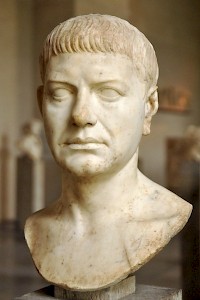Pontius Pilate
Pontius Pilate: Roman prefect of Judaea from 26 CE to 36 CE, best known for the execution of Jesus of Nazareth.
Sources

The forty something provinces of the Roman Empire were ruled by a governor whose term lasted twelve or thirty-six months. These powerful men are virtually unknown to modern historians, who consider themselves lucky when they happen to know who was responsible for a province at a certain moment. There are, however, some exceptions. One governor, Pliny the Younger, left a collection of letters showing us something of the provincial administration. The other exception is Pontius Pilate, who is mentioned in the gospels and in several almost contemporary Jewish sources.
If we are to believe the gospels, Pilate refused to condemn Jesus of Nazareth, but was forced to execute him by a hysterical Jewish crowd. Unfortunately, it is difficult to infer the historical truth from the gospels, which are theological treatises. Written in the last decades of the first century, when some Christians had been martyred by the Roman authorities, the authors wanted to show that Christianity was not a subversive organization. Stories about Pilate's doubts and Jewish agitation may have been exaggerated if not invented.
If we turn to the Jewish sources, we encounter the opposite problem. Writing after the war between the Jews and the Romans of 66-70, the Jewish historian Flavius Josephus tries to explain to the non-Jewish public that misgovernment by certain governors added fuel to a smoldering fire. Although his main scapegoat is one Gessius Florus, his portrait of Pilate is little short of a character assassination.
In the text known as the Embassy to Caligula, Philo of Alexandria includes a letter by the Jewish prince Herod Agrippa to the emperor Caligula, in which the latter's attempt to have his statue erected in the Temple at Jerusalem is compared to Pilate's attempt to have shields with pagan inscriptions placed in his Jerusalem palace. According to the author of this letter, Pilate was corrected by the emperor Tiberius, whose behavior is presented as exemplary. To present Tiberius as a virtuous ruler, Pilate had to be presented as incompetent. Besides, it should be noted that Agrippa wanted to become king of Judaea; a negative portrait of Roman administration might convince the emperor that there was a real need for his accession. (The letter served both purposes; Caligula backed down and Herod Agrippa was made king of Judaea.)
Summing up, we may conclude that the gospels do not represent the historical truth when they show us a well meaning but weak Pilate. On the other hand, the two Jewish sources have their own agendas. If we want to reconstruct the historical truth, we will have to be extremely careful.